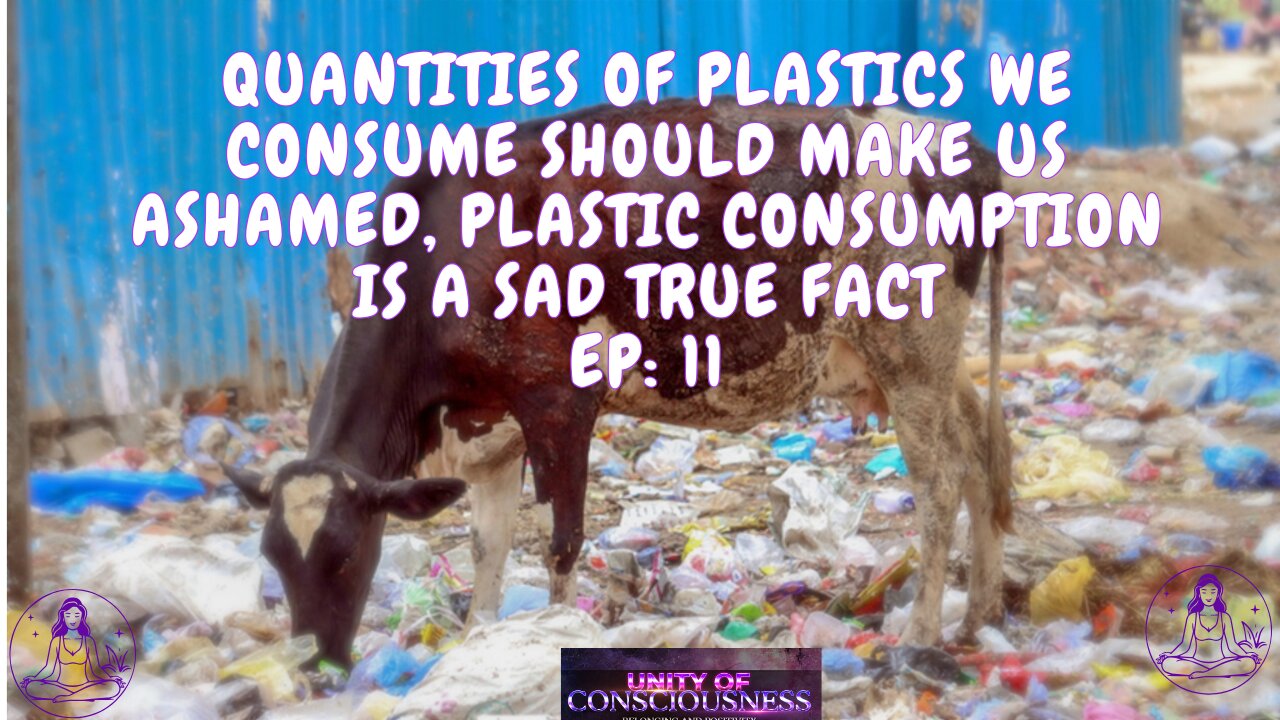Premium Only Content

Quantities of Plastics we Consume should make us ASHAMED, Plastic Consumption is a Sad True Fact
#PlasticConsumedbyHumans #PlasticConsumedbyAnimals #PlasticConsumedbyMarineAnimals
@unityofconsciousness475
Hi There
- You are made of: GREATNESS, PURE LOVE & LIGHT
-Link for the long video:
In today's world, plastics are everywhere—from packaging and household items to clothing. In fact, many everyday products like food containers, water bottles, and even personal care items are heavily infused with plastic materials. Each year, we produce over 400 million tons of plastic globally, with 9 million tons ending up in landfills. The fashion industry also contributes significantly, producing textiles infused with plastics, with over 90 million tons disposed of annually. Alarming amounts of plastic particles are consumed daily, not only by humans but also by land and sea animals, adding to the environmental burden.
--Unity of Consciousness is a YouTube channel dedicated to providing a serene and calming experience through meditation and relaxation music; wisdom for well-known spiritual people, and everyday people with their mission in finding happiness. Our channel offers a wide range of soothing melodies and compositions designed to help you unwind, de-stress, and find inner peace. We also, have dedicated ourselves to find you the best tips and experiences for happiness and spiritual growth.
--Please follow us on our channels for more relaxation music & more
- https://www.youtube.com/@unityofconsciousness475?sub_confirmation=1
-https://rumble.com/c/c-1451613
----Disclaimers:
Video is made by Unity of Consciousness via Fliki
-Text: Unity of Consciousness
-Music from Youtube Library
--References for shorts: In the Comments
References
• Geyer, R., Jambeck, J. R., & Law, K. L. (2017). Production, use, and fate of all plastics ever made. Science Advances, 3(7), e1700782.
• Thompson, R. C., Moore, C. J., Vom Saal, F. S., & Swan, S. H. (2009). Plastics, the environment and human health: current consensus and future trends. Philosophical Transactions of the Royal Society B: Biological Sciences, 364(1526), 2153-2166.
• Eriksen, M., Lebreton, L. C. M., Carson, H. S., et al. (2014). Plastic pollution in the world's oceans: more than 5 trillion plastic pieces weighing over 250,000 tons afloat at sea. PLOS ONE, 9(12), e111913.
• Plastic Soup Foundation. (2021). Microplastics in cosmetics: why you should care. Plastic Soup Foundation. Retrieved from https://www.plasticsoupfoundation.org
• PlasticEurope. (2021). Plastics – the Facts 2021. PlasticEurope Report.
• National Geographic. (2022). A Whopping 91% of Plastic Isn’t Recycled. National Geographic Report.
• Our World in Data. (2021). Plastic Pollution. OWID Data on Plastics.
• Ellen MacArthur Foundation. (2017). The New Plastics Economy: Rethinking the Future of Plastics & Catalysing Action. EMF Report.
• Statista. (2021). Global plastic production from 1950 to 2020. Statista Report.
• United Nations Environment Programme (UNEP). (2018). Single-use Plastics: A Roadmap for Sustainability. UNEP Report.
• Science Direct. (2021). Plastic Landfill Accumulation and Its Long-Term Environmental Impact. Science Direct Article.
• European Environmental Agency. (2019). Plastics in Europe: Insights into Plastic Consumption and Waste. EEA Report.
• EPA (Environmental Protection Agency). (2020). Landfills in the U.S. and Plastic Waste Disposal Trends. EPA Report.
• OECD (Organisation for Economic Co-operation and Development). (2020). Plastic Waste Disposal Patterns and Landfill Statistics. OECD Report.
• Ellen MacArthur Foundation. (2020). "A New Textiles Economy: Redesigning Fashion's Future."
• Textile Exchange. (2021). "Preferred Fiber & Materials Market Report."
• United Nations Environment Programme (UNEP). (2020). "Sustainability and Circularity in the Textile Value Chain."
• Environmental Protection Agency (EPA). (2018). "Advancing Sustainable Materials Management: Facts and Figures Report."
• European Environment Agency (EEA). (2021). "Textile Waste in the EU: A Growing Environmental Concern."
• World Health Organization (WHO). (2019). Microplastics in drinking-water. Link to publication
• WWF Report. (2019). Plastic ingestion by humans: A study into the impact of plastic on human health. WWF International.
• National Oceanic and Atmospheric Administration (NOAA). (2020). Plastic pollution in marine ecosystems. Link to publication
• Thompson, R.C., et al. (2004). Lost at sea: Where is all the plastic? Science, 304(5672), 838. Link to journal
• Lusher, A.L., et al. (2013). Microplastics in the marine environment: distribution, interactions, and effects. Marine Pollution Bulletin, 62(12), 2456–2461.
--All rights reserved to: Unity of Consciousness
-Eternally Thankful
-If you are inspired, please subscribe, like and share
-
 1:21:11
1:21:11
UNITY OF CONSCIOUSNESS
5 days ago $0.05 earnedProtection of Angels and Archangels • 1111Hz Healing for Body, Soul, and Spirit, Total Restoration
592 -
 DVR
DVR
Mostly Sports With Mark Titus and Brandon Walker
21 hours agoMostly Sports With Mark Titus and Brandon Walker Presented by Jägermeister | EP 302 | 12.3.24
2.02K2 -
 LIVE
LIVE
TheAlecLaceShow
3 hours agoHunter Biden Pardoned | Who’s Next? | Kash Only | Racism | Guest: Franck Zanu | The Alec Lace Show
132 watching -
 LIVE
LIVE
G2G Gaming Channel
5 hours agoI heard Smite, So Im here! #RumbleTakeOver #RumbleGaming
212 watching -

Neil McCoy-Ward
1 hour ago🚨 Emergency Martial Law Declared, Special Forces Deployed...
321 -
 LIVE
LIVE
The Charlie Kirk Show
1 hour agoDemocrat Billionaires in Crisis + Fixing the Migrant Crisis | Blagojevich, O'Brien, Metaxas| 12.3.24
8,390 watching -
 1:01:07
1:01:07
The Dan Bongino Show
4 hours agoBiden’s Reign Of Destruction Isn’t Over Yet (Ep. 2381) - 12/03/2024
495K1.04K -
 1:59:02
1:59:02
Steven Crowder
4 hours ago🔴 COVID Chronicles: The Hidden Truths of the Pandemic Exposed
286K172 -
 LIVE
LIVE
SoundBoardLord
2 hours agoMulti-Gen Don Juan in Full Force!
232 watching -
 1:08:54
1:08:54
MTNTOUGH Fitness Lab
2 hours agoSheriff Mark Lamb Exposes America’s Border Crisis and Cartel Infiltration | MTNT POD#93
8561